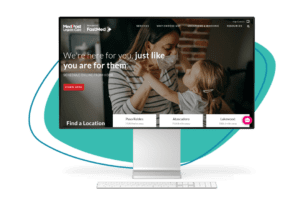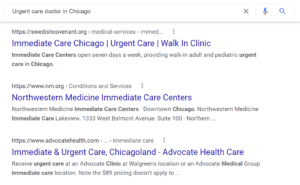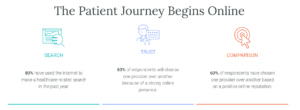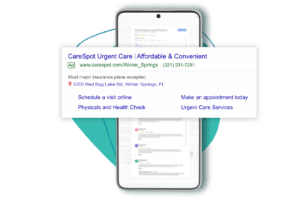As an urgent care provider, you face an impatient audience. They need help now, and the provider that can see them the soonest will win. As a result, the key to your patient acquisition is showing up when people seek help. In this strategy guide, we will cover everything you need to reach more individuals in need, including:
Table of Contents
- Why Urgent Care Needs Digital Marketing
- Operational Alignment: The Key to Urgent Care Marketing Success
- Website = Your Urgent Care’s Digital Front Door
- Telehealth Marketing for Urgent Care Providers
- Local SEO for Urgent Care
- Urgent Care Brand Reputation Management
- Urgent Care Google Ads Strategy
- Data-Driven Marketing for Urgent Care Providers
- Conclusion
Why Urgent Care Needs Digital Marketing
A study of more than 1,700 U.S. adults found that 80% of respondents research on Google independently before ever speaking to a doctor, and 63% of respondents would choose the provider with a stronger online presence over their competitors. Therefore, having an effective urgent care marketing strategy will set your institution apart from the rest.
When a medical emergency occurs, people instantly turn to their phone for an answer — not to make a call, but to get on Google. However, urgent care is an intent-driven niche whose marketing strategy must heavily focus on the bottom of the funnel. Therefore, your strategy needs to maximize your online presence, communicate your availability, and create easy ways to convert.
Urgent Care vs. ER
Emergency rooms (ERs) are your biggest competitor. Amidst a medical emergency, most patients are stressed out, if not panicking. Therefore, you have a limited window to convince them that coming to you, an urgent care provider, is a better decision than going to the ER.
This requires an extremely effective marketing strategy that presents patients with the exact information they need: how you can help them, what services you offer, and why ER is not always the best solution.
Operational Alignment: The Key to Urgent Care Marketing Success
Before attempting your marketing efforts, ensure your business and marketing are aligned.
In my years working with urgent care providers, I’ve learned that syncing marketing with operations is paramount. Think about it: have you ever run a great campaign only to overwhelm your centers?
It happens, but we can avoid it.
I always tell my clients that marketing and operations are two sides of the same coin. Your strategies should support overall business goals, not just attract patients. When planning campaigns, consider capacity, staffing, and service priorities.
Work on these categories for total alignment:
Practice Capacity Alignment
For urgent care providers, understanding and aligning with practice capacity is crucial. Your marketing efforts should reflect the real-time availability of your centers. Here’s how to achieve this:
- Real-time capacity tracking: Implement a system that allows your marketing team to access up-to-date information on wait times and patient volumes across all locations. This data can inform your digital advertising efforts, ensuring you’re not driving traffic to overcrowded centers.
- Dynamic ad scheduling: Use your capacity data to adjust your Google Ads and social media campaigns in real-time. For example, if one location is experiencing a lull, you can increase ad spending in that area to drive more patients there.
- Wait time transparency: Integrate wait time information into your website and Google Business Profile. This transparency can help manage patient expectations and distribute patient flow evenly across your locations.
By aligning your marketing with practice capacity, you’ll improve patient satisfaction and optimize your ad spend. Remember, in urgent care, timing is everything—both for patients and for your marketing efforts.
Service Line Alignment
Urgent care centers often offer a variety of services beyond basic urgent care. Aligning your marketing efforts with your service lines can help you maximize profitability and patient satisfaction:
- Prioritize high-value services: Work with your operations team to identify which services are most profitable or have the highest patient lifetime value. For instance, if your occupational health services are particularly lucrative, you might create targeted campaigns for local businesses.
- Seasonal marketing: Align your marketing with seasonal health trends. For example, ramp up marketing for flu shots and cold treatments during fall and winter or focus on sports physicals before school seasons start.
- Cross-promotion strategies: Develop marketing strategies that promote complementary services. For example, if a patient comes in for a minor injury, your follow-up communication could inform them about your physical therapy services.
By aligning your marketing with your service lines, you can ensure that you’re not just filling your waiting rooms but doing so with the right mix of patients for your business goals.
Technology Alignment
In the urgent care sector, where speed and efficiency are paramount, technology plays a crucial role in both operations and marketing. Aligning these two areas can significantly enhance your marketing effectiveness and operational efficiency.
Integrating Patient Flow Management and Marketing
One of the unique challenges in urgent care marketing is balancing patient acquisition with capacity management. Here’s how technology alignment can help:
- Smart scheduling systems: Implement advanced scheduling software that integrates with your marketing platforms. This allows you to adjust your digital ads in real-time based on current wait times and capacity.
- Automated patient communications: Use a system that sends automated updates to patients about their expected wait times. This not only improves the patient experience but also allows your marketing team to promote less busy times or locations.
- Data-driven decision-making: Utilize analytics tools that combine operational data (patient flow, treatment times) with marketing metrics (ad performance, website traffic). This comprehensive view allows for more informed marketing strategies that align with operational realities.
For example, if your analytics show that Mondays are typically your busiest days, you might adjust your marketing to promote weekend visits or early morning Tuesday appointments, helping to distribute patient flow more evenly.
Leveraging Telemedicine in Marketing Strategies
Speaking of technology, as telemedicine becomes increasingly important in urgent care, aligning your marketing efforts with this digital solution can open new avenues for patient acquisition and retention:
- Promote convenience: In your marketing materials, highlight the ease and speed of telemedicine consultations. For instance, create campaigns that emphasize “Skip the waiting room” or “See a doctor in minutes.”
- Target specific demographics: Use data from your telemedicine platform to identify which patient groups are most likely to use virtual visits. Tailor your marketing efforts to these demographics.
- Integrate telemedicine with in-person care: Market your urgent care as a comprehensive solution where patients can start with a virtual visit and seamlessly transition to in-person care if needed.
By aligning your marketing strategies with your telemedicine capabilities, you can attract tech-savvy patients and differentiate your urgent care center from competitors.
Remember, the goal of technology alignment is not just to have the latest tools but to use them to enhance your marketing efforts and operational efficiency. This synergy is key to standing out in the competitive urgent care landscape.
Website = Your Urgent Care’s Digital Front Door
Urgent care providers need a robust website to capture and acquire patients at their moments in need. Patients are looking for immediate availability and will choose the provider that they can see soonest.
Focus on delivering a simple, stress-free user experience with a straight-foward design, precise information, and easy ways to get in touch with you. Optimize your website for the mobile end because many of your patients will be searching on the go.
Provide Necessary Information
When it comes to your website content, put the most important information in front of your site visitors. Provide comprehensive information on the services you offer and doctors at each location. Make payment, insurance, and booking information easy to find.
For urgent care, the most critical information to consumers is your hours of operation, typical wait times, and appointment availability. No one wants to show up to an urgent care provider and wait five hours.
Integrate online booking with your website to give prospective patients insight into wait times or offer a “virtual” waiting room. This will allow you to set expectations with patients and potentially allow them to wait in the comfort of their homes for their appointment.
Meanwhile, publish educational blogs to capture TOF and MOF patients and generate more demand. Since your biggest competitor is ER, you’ll need content explaining what conditions don’t require an ER visit. With most patients panicking during a medical emergency, it’s essential to explain that their situation isn’t as dire as they believed and that an urgent care provider is a viable option.

Focus on User Experience
Once again, patients needing urgent care are impatient, irritated, and often scared. They don’t have time to wait for pages to load, search through complicated navigation menus, or reconnect every time they refresh. Therefore, your website must provide a positive, supportive, and uninterrupted patient experience.
Telehealth Marketing for Urgent Care Providers
If your urgent care offers telehealth options to augment in-person provider availability, market them to the fullest. For example, patients seeking urgent care need to speak with a doctor ASAP, and telehealth allows you to evaluate their current situation without visiting in person.
Consumer adoption of telehealth skyrocketed after over two years of the pandemic, increasing from 11% at the beginning of 2019 to an astonishing 46%, mainly because telehealth minimizes the impact of staff shortage and improves patients’ experience and accessibility to quality healthcare.
Telehealth Marketing Best Practices
Like all other digital pieces in your urgent care marketing strategy, mobile accessibility and user experience are key.
Craft your message to capture your audience’s attention. Although today’s patients are more familiar with telehealth than a few years ago, educational content, success stories, and testimonials are still great ways to move them down the funnel. Once your content is in place, leverage Google PPC ads and your Google Business Profile listings to capture BOF purchase-ready patients.
Finally, make your patient’s experience as convenient and comfortable as possible. For example, some providers offer a digital wait room with a countdown timer. Others deploy telehealth mobile apps for a more accessible and convenient experience.
Learn more about telehealth marketing best practices
Local SEO for Urgent Care
Urgent care is a local service because patients don’t have the luxury of driving an extra fifteen minutes for a different provider. Therefore, unlike many other healthcare services, such as dermatology and orthodontics, the urgent care market is much smaller for an individual location.
As a result, local SEO should be the primary player in your patient acquisition strategy, especially if you’re not running paid ads just yet.
Listings & Citations
List your urgent care organization and doctors on local directories and healthcare platforms like Zocdoc. Ensure all availability, service, and insurance information is accurate and updated.
Google Business Profile (formerly GMB)
Create a Google Business Profile listing for each location and utilize the healthcare-specific attributions to make your audience’s research easier. Link your phone number, website, and a direct booking link to provide multiple ways of conversion. You should also create an FAQ section under your listing based on questions you received from past patients.
Geographical Keyword Strategy
Geographical keyword strategy is the bread and butter of your local patient acquisition. With local keywords, focus on high-intent, MOF, and BOF keywords. These keywords are either problem-aware or solution-aware. For example,
- Burn treatment near me
- High fever doctor open now
- Urgent care doctor in Chicago

Optimized Location Pages
Optimize your location pages following your geographical keyword strategies. Make sure you implement all the website best practices on your location pages. However, diversify your content to suit each local market, such as location-specific treatment information, about us pages, insurance policy, and separate booking links.
Once again, give your audience a seamless mobile experience and make conversion easy.
Urgent Care Brand Reputation Management
As we mentioned, patients seeking urgent care are impatient and stressed, if not scared. This vulnerability also makes them highly sensitive. As a result, your patients are
- More skeptical when researching providers even though it’s an urgent situation
- More likely to leave a negative review or complain to their friends and families over the slightest discomfort
Therefore, brand reputation management is one of the most critical pieces in an urgent care marketing strategy.

Reputation Management Best Practices
Start with building a positive reputation by gathering reviews from online platforms and existing patients. Urgent care providers must also know when to ask for a review since they must focus on providing treatment first. We also recommend investing in an automated review solicitation system for an easier process.
Meanwhile, stay aware of all your listings and respond to negative reviews as soon as possible. On the other hand, showcase success stories, testimonials, and doctor’s recognitions on your website to boost your reputation.
Learn more about healthcare reputation management best practices
Urgent Care Google Ads Strategy
Google PPC campaign is a powerful tool for urgent care providers. The campaigns place you directly in front of patients in dire need, so you can capture them when their demand peaks. However, unlike many other healthcare services, people searching for urgent care aren’t waiting for anything. Therefore, you must be at the top of SERP to capture them.
Account Structure
Just how much difference can a well-structured Google Ads account bring?
With our integrated PPC and SEO strategy, Carespot, a multi-location nationwide urgent care provider, gained over 173K digital leads in 9 months, among which over 88K were paid digital leads with a blended cost per lead of $3.94.
Utilizing center-level budgeting, we chose a hybrid account structure that allowed budget control for individual locations without sacrificing the efficiency a consolidated account structure brings, which allowed us to optimize for maximized impressions on direct response keywords.
This approach allows us to take advantage of Google’s AI-powered smart bidding function while maintaining budget and geofencing control on each location.

Google Ads Best Practices
A few other best practices to maximize your google ads ROI include
- Optimize your bidding strategy to leverage Google’s Smart Bidding
- Implement conversion tracking
- Identify winning ad messaging with A/B testing
- Optimize your ads for a better mobile experience
- Create unique landing pages for each campaign and optimize them following website best practices
Once your Google PPC campaigns and organic SEO efforts join forces, you will soon gain a significant increase in high-intent leads who are ready to go to your urgent care.
Learn more about PPC best practices
Data-Driven Marketing for Urgent Care Providers
Visibility allows you to optimize and adjust your urgent care marketing strategy for sustainable long-term results. With a data-driven approach, your marketing team can then separate data together to paint the whole picture. This gives you insight into how each investment and strategy perform, allowing you to make informed decisions for better results.
Closed-Loop Reporting (CLR) In Urgent Care Patient Acquisition
Closed-loop reporting (CLR) allows your marketing team to view data throughout a patient’s journey. Essentially, CLR answers a core question: how many of the leads that came through a campaign became actual patients?
When implementing CLR, your attribution model determines how you view your data:
- First-touch captures the very first interaction a lead has with you. This is a great way to measure impression and clickthrough.
- Last-touch captures the last interaction before a lead becomes a patient. This can provide consumer behavior insights and help you choose the right campaign format to increase conversion.
- Linear mapping accredits each touchpoint from a lead’s entry point to patient acquisition. This is a great method to map out your patient’s journey.
- Multi-touch is similar to linear but assigns credits proportionally according to how impactful each interaction point is on the final acquisition. This allows you to identify the weakest and strongest links in your urgent care marketing strategies.
Learn to implement CLR for your urgent care organization
Marketing Analytics Best Practices
Measuring urgent care marketing return can be tricky. Unlike specialty care or cosmetics healthcare services, urgent care patients often walk into your facilities to get treatment without leaving a digital history.
Therefore, your top priority is data clarity. First, build a centralized system that captures activities on the traditional and digital side, then create interactive and shareable reports and dashboards for your team to collaborate across departments.
Meanwhile, invest in project management tools to improve your team’s communication, integrate and connect all your other systems, and choose the right KPI to track your progress in reaching each goal.
Conclusion
Urgent care marketing is about offering help to an overwhelmed audience in desperate need of fast yet quality healthcare solutions. This means urgent care providers must focus on capturing high-intent leads first, then help MOF patients understand why urgent care is a better option than emergency rooms in most cases.
On the other hand, your audience’s unique vulnerability and sensitivity mean that you must invest heavily in local SEO and reputation management. After all, nobody wants to take the risk and trust someone with a bad name with their urgent medical needs. Lastly, ensure your marketing and day-to-days are in-line with each other to best serve your overall business goals.

